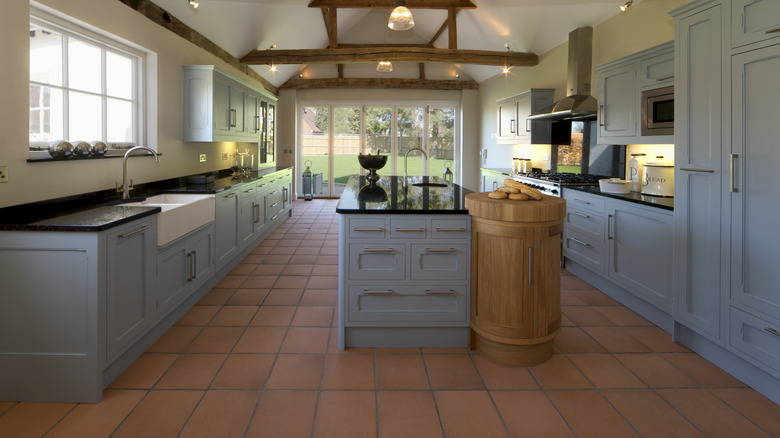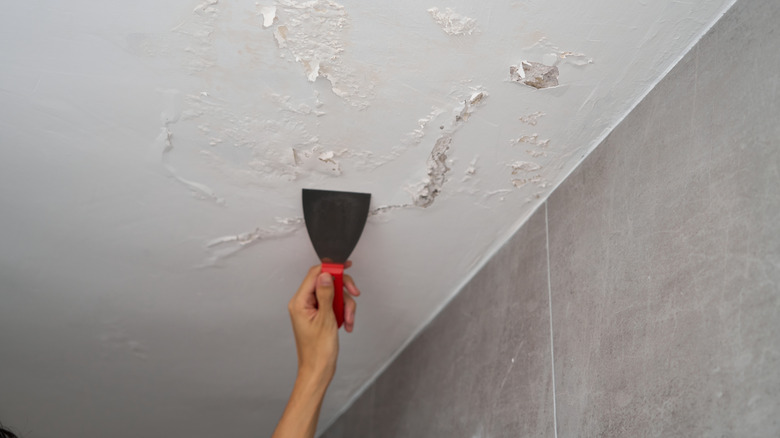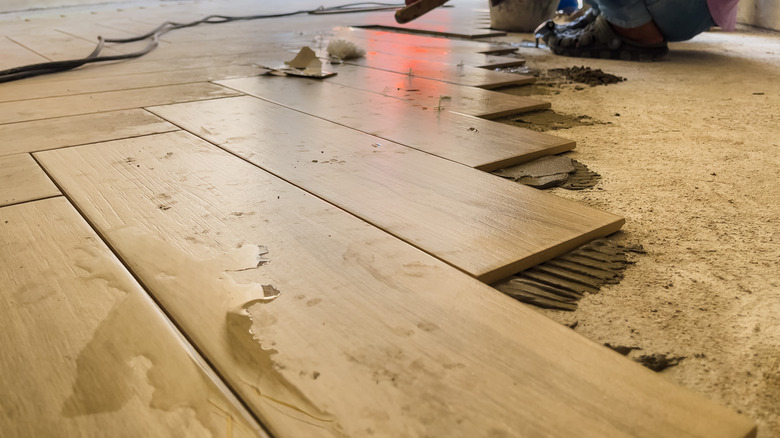Mike Holmes Warns Of A Mistake That Could Cost You When Replacing Kitchen Floors
There are budget-friendly kitchen upgrades that don't involve remodeling, but skipping key steps can lead to costly consequences. One mistake homeowners often make has to do with not installing the tiles correctly. Mike Holmes, known for his no-nonsense approach, warns against this shortcut, stating on his Make It Right website, "When putting in a new floor, a lot of homeowners leave the existing cabinet boxes in place and tile up against them. This is not a good idea!" He then goes on to explain that it can lead to long-term issues that are far more expensive to fix. Tiling under cabinets ensures a level floor, protects against water damage, and makes subsequent renovations easier. And, if a contractor with over 35 years of experience warns of future expenses, you bet we're listening and taking extensive notes.
The cost of tiling a kitchen varies depending on materials and labor, but the average ranges from $5 to $17 per square foot, according to HomeAdvisor. A standard 200-square-foot kitchen floor could cost between $1,000 and $3,500 to tile, which is certainly not cheap, and extending those tiles under cabinets might add a few hundred dollars to the bill. While you may be tempted to cut costs by skipping these hidden areas, Holmes stresses that doing so often leads to even greater expenses down the line. So, you may as well do it professionally, and cut out ever having to do future patchwork jobs if the cabinets ever need to be replaced or repositioned.
The biggest risk: water damage and structural issues
HGTV star Mike Holmes makes it clear that moisture is the real enemy. He explained, "If there is ever a leak underneath the sink or the dishwasher leaks, you won't see it and that water will end up going downstairs." When cabinets sit directly on subflooring, any water that seeps beneath can create a hidden problem. Spills, leaks from appliances, or even everyday cleaning can lead to water getting trapped under the cabinetry, causing gradual deterioration of the subfloor. Over time, this trapped moisture can weaken the structural integrity of the kitchen floor.
As Holmes pointed out, this issue becomes even more serious in upper-level kitchens and bathrooms. Water pooling under cabinets on a second floor can eventually seep through ceilings, causing damage to the rooms below. However, if you're already in this position, we're here to guide you through repairing water damage should it be necessary.
But, it gets worse. According to the Environmental Protection Agency, moisture problems left unaddressed can lead to mold growth within 24 to 48 hours. While Holmes doesn't explicitly call it a health hazard, if you are exposed to mold over a period of time, it can lead to respiratory problems for those who live in the house. If you think about it, the expense of replacing water-damaged flooring and cabinetry, as well as possible medical expenses, can quickly add up to more than the cost of simply tiling under the cabinets from the start.
Future-proofing your kitchen by tiling under cabinets
Not tiling under cabinets might not seem like a big deal—until you want to renovate. Mike Holmes advises, "When speaking to your contractor or kitchen floor installer, make it clear that the entire floor needs to be replaced, including underneath the cabinets. Make sure it's in the contract! That's why most homeowners will change the cabinets when they install a new kitchen floor. If it isn't done, and it was in the contract, your contractor is under obligation to fix it."
Holmes also points out that cabinets and tiles are usually replaced simultaneously. It helps to avoid the issue of moving or replacing your cabinets only to find gaps where there's no tile. Now you are forced to hunt down matching flooring, or even worse, redo the entire kitchen floor. As you can imagine, finding an exact match years later is nearly impossible, often leading to the need for a full retiling job. Likewise, leaving flooring unfinished beneath cabinets can cause issues if you ever decide to reconfigure your kitchen layout. Needless to say, these changes could require extensive and costly floor repairs, adding time and frustration to the process.
Contractors often tell us the home improvements you shouldn't cheap out on because, in the long run, it only adds unnecessary hassle and expense. And that is exactly why you should follow Holmes' advice for greater peace of mind.


